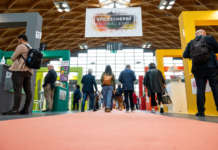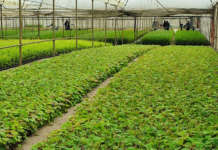Allo stand di Fruit Logistica di Melinda abbiamo potuto scoprire più da vicino il progetto che prevede il trasporto delle mele sulla funivia da parte del consorzio e ne abbiamo parlato con il presidente del Consorzio e di Apot, Ernesto Seppi. Qui sotto vi lascio l’articolo di Vittorina Fellin, pubblicato sul numero 1 di Fresh Point Magazine 2024, distribuito a Berlino, che racconta più in dettaglio il progetto della costruzione del tratto di funivia, che sarà in funzione dalla prossima stagione melicola.
di Vittorina Fellin
Dopo le celle ipogee, il Consorzio Melinda si fa portavoce di altre importanti istanze in tema di sostenibilità e rilancia con un nuovo progetto che prevede la realizzazione di un impianto a fune per il trasporto delle mele. Unica al mondo, la funivia collegherà uno degli stabilimenti di Melinda con la miniera Rio Maggiore in Val di Non, dove attualmente sono stoccate una parte delle mele nelle celle ipogee. Entro il 2024 l’impianto sarà in grado di trasportare 40 mila tonnellate di frutta evitando i 12 mila chilometri annui attualmente percorsi con veicoli su gomma. Un progetto importante, ideato dallo stesso Consorzio, che si è posizionato al secondo posto nel bando dedicato alle migliori idee per lo sviluppo della logistica agroalimentare su un totale di oltre 100 proposte che accederanno ai fondi Pnrr. Un impegno anche in termini economici che comporterà una spesa complessiva di 10 milioni di euro e che, grazie al contributo a fondo perduto ottenuto sui fondi del piano di poco più di 4 milioni di euro, permetterà una copertura del 40% della spesa complessiva.
Gli aspetti tecnici del progetto
La funivia sarà un impianto monofune ad agganciamento automatico a tre piloni con 11 piloni di sostegno (di cui 6 in galleria) della lunghezza di 1300 metri e un dislivello di 87 metri, capace di trasportare ogni ora 460 contenitori impilabili o “bins”, alla velocità di 5 metri al secondo. La partenza dell’impianto sarà presso la sala di lavorazione di Predaia e arriverà fino alla Miniera di Rio Maggiore esattamente all’interno delle cave realizzate per estrarre la roccia dolomia. Qui il percorso proseguirà in galleria per altri 430 metri per raggiungere il luogo dove sono collocate le celle ipogee, l’impianto di frigoconservazione “naturale” dove sono collocate una parte delle mele del Consorzio della Valle di Non. Un gioiello tecnologico unico al mondo che oggi permette un risparmio energetico di almeno il 30% rispetto alla più tradizione conservazione in celle frigorifere ed evita la costruzione di nuovi impianti, spesso a forte impatto ambientale in una valle fortemente vocata anche al turismo, sottraendo superfici preziose all’attività agricola. L’ultimo tratto di galleria -secondo quanto precisato da Ernesto Seppi, presidente del Consorzio-, è già in costruzione la conclusione è prevista entro pochi mesi.
Innovazione e sostenibilità spingono prodotto e territorio
Secondi i calcoli elaborati da Melinda, l’impianto permetterà di evitare 6.000 viaggi di tir su gomma, per un totale di 12.000 chilometri l’anno, con una significativa diminuzione delle emissioni di CO2 sui percorsi in Val di Non. Per gestire lo stoccaggio degli stessi volumi movimentati dalla nuova teleferica, sarebbero necessari 10 camion che dovrebbero effettuare complessivamente 80 viaggi al giorno, trasportando ciascuno 36 bins a cui va associato il flusso di svuotamento delle celle ipogee tra novembre e luglio per permettere la commercializzazione del prodotto.
Scopri lo speciale da Fruit Logistica 2024
Apples go by cable car
The aim is to reduce road vehicles for transporting apples and replace them with solutions with a lower environmental impact. Melinda launches into an innovative sustainability project that is also good for its brand
After underground cells, Melinda Consortium becomes the spokesperson for other important issues regarding sustainability and relaunches with a new project that involves the construction of a cableway system for the transport of apples. Unique in the world, this cable car will connect one of the Melinda factories with Rio Maggiore mine in Val di Non, where part of the apples is currently stored in underground cells. By 2024, the plant will be able to transport 40 thousand tonnes of fruit, avoiding 12 thousand kilometres per year currently travelled by road vehicles. We are talking about an important project, conceived by the Consortium itself, which placed second in the tender dedicated to the best ideas for the development of agri-food logistics out of a total of over 100 proposals that will access the NRRP (National Recovery and Resilience Plan) funds. It is a commitment in economic terms, too, which will involve a total expenditure of 10 million Euros and which, thanks to the non-repayable contribution obtained from the NRRP funds of just over 4 million Euros, will allow coverage of 40% of the overall expenditure.
Technical aspects of the project
The cableway will be a mono-cable system with automatic coupling to three pylons, with 11 support pylons (6 of which in the tunnel), with a length of 1,300 meters and a height difference of 87 metres, capable of transporting 460 stackable containers or ‘bins’ every hour, whose speed is 5 meters per second. The start of the plant will be at the processing room at Predaia, and will reach Rio Maggiore mine exactly inside the quarries created to extract the dolomite rock. Here the route will continue in the tunnel for another 430 meters, to reach the place where the underground cells are located, the ‘natural’ cold storage system where part of the apples of Valle di Non Consortium is placed. A technological jewel unique in the world, which today allows an energy saving of at least 30% compared to the more traditional conservation in cold storage and avoids the construction of new plants, often with a strong environmental impact in a valley also strongly suited to tourism, taking precious surfaces away from agricultural activity. The last section of the tunnel – as specified by Ernesto Seppi, President of the Consortium – is already under construction and is expected to be completed within a few months.
Innovation and sustainability favour both product and territory
According to calculations developed by Melinda, the system will make it possible to avoid 6,000 road truck trips, for a total of 12,000 kilometres per year, with a significant reduction in Co2 emissions on routes in Val di Non. To manage the storage of the same volumes moved by the new cableway, 10 trucks would be needed, which would have to make a total of 80 trips per day, each carrying 36 bins that must be associated with the emptying flow of the underground cells between November and July to allow the marketing of the product. These numbers, among other things, would be destined to increase by 30% in the absence of the cableway, as soon as the expansion works on the underground cells are completed, which are leading to an increase of up to 40,000 tonnes in the apple storage capacity inside the mountain. But Melinda, which has always been attentive to the needs of its territory, sets itself a further objective, which expresses company’s attention towards resources and sustainability, key elements for consumers today, capable of having a decisive impact on the reputation of the brands. Seppi concluded: ‘We want to be able to transform an industrial innovation into a tool for territorial valorisation. Thanks to it, we will soon be able to tell tourists the story behind each of our apples and the innovation efforts to make this activity increasingly sustainable. We are certain that a visit to the underground cells will become one of the strong points of both Trentino region and national tourist offer, and will allow guests to live a unique experience in the world’. This proposal will certainly be good for the environment and, as the underground cell project, it will become a significant image factor and driving force for performance.









